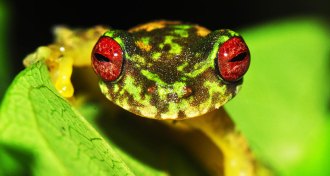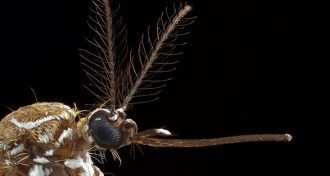Uncategorized
-
 Animals
AnimalsChytrid’s frog-killing toll has been tallied — and it’s bad
Losses due to the amphibian-killing chytrid fungus are “the greatest documented loss of biodiversity attributable to a pathogen,” researchers find.
-
 Animals
AnimalsGeneticists close in on how mosquitoes sniff out human sweat
A long-sought protein proves vital for mosquitoes’ ability to detect lactic acid, a great clue for finding a human.
By Susan Milius -
 Health & Medicine
Health & Medicine50 years ago, drug abuse was higher among physicians than the public
In 1969, physicians abused drugs at a higher rate than the general public — that’s still true today.
By Jeremy Rehm -
 Health & Medicine
Health & MedicineBlood vessels built from a patient’s cells could help people on dialysis
Bioengineered blood vessels could provide a safer alternative than donor vessels or synthetic implants.
-
 Health & Medicine
Health & MedicineTreating cystic fibrosis patients before birth could safeguard organs
Starting a cystic fibrosis drug sooner than usual may protect an afflicted child’s lungs, pancreases and reproductive tissue, a study in ferrets hints.
-
 Planetary Science
Planetary ScienceKuiper Belt dust may be in our atmosphere (and NASA labs) right now
Bits of space debris that collect in Earth’s atmosphere may come from as far as the cold, distant Kuiper Belt region beyond Neptune.
-
 Science & Society
Science & SocietyThe science of CBD lags behind its marketing
Editor in Chief Nancy Shute discusses the lack of scientific research on CBD.
By Nancy Shute -
 Tech
TechReaders respond to classroom robots, soil erosion and more
Readers had comments and questions about robots in classrooms, benzodiazepines and more.
-
 Science & Society
Science & SocietyThe CBD boom is way ahead of the science
As CBD-laced foods and health products gain popularity, researchers are just beginning to fill the gaping holes in knowledge about this cannabis molecule’s benefits.
-
 Health & Medicine
Health & MedicineEpileptic seizures may scramble memories during sleep
Overnight seizures seemed to muddle memories in people with epilepsy.
-
 Health & Medicine
Health & MedicineSperm with damaged DNA may cause some repeat miscarriages
An analysis of semen from men whose partners have experienced multiple miscarriages revealed abnormalities, a small study finds.
-
 Health & Medicine
Health & MedicineA single sweaty workout may boost some people’s memory
Memory improvements after a short bout of exercise mirrored those seen after months of training.